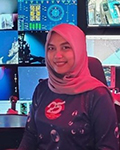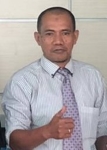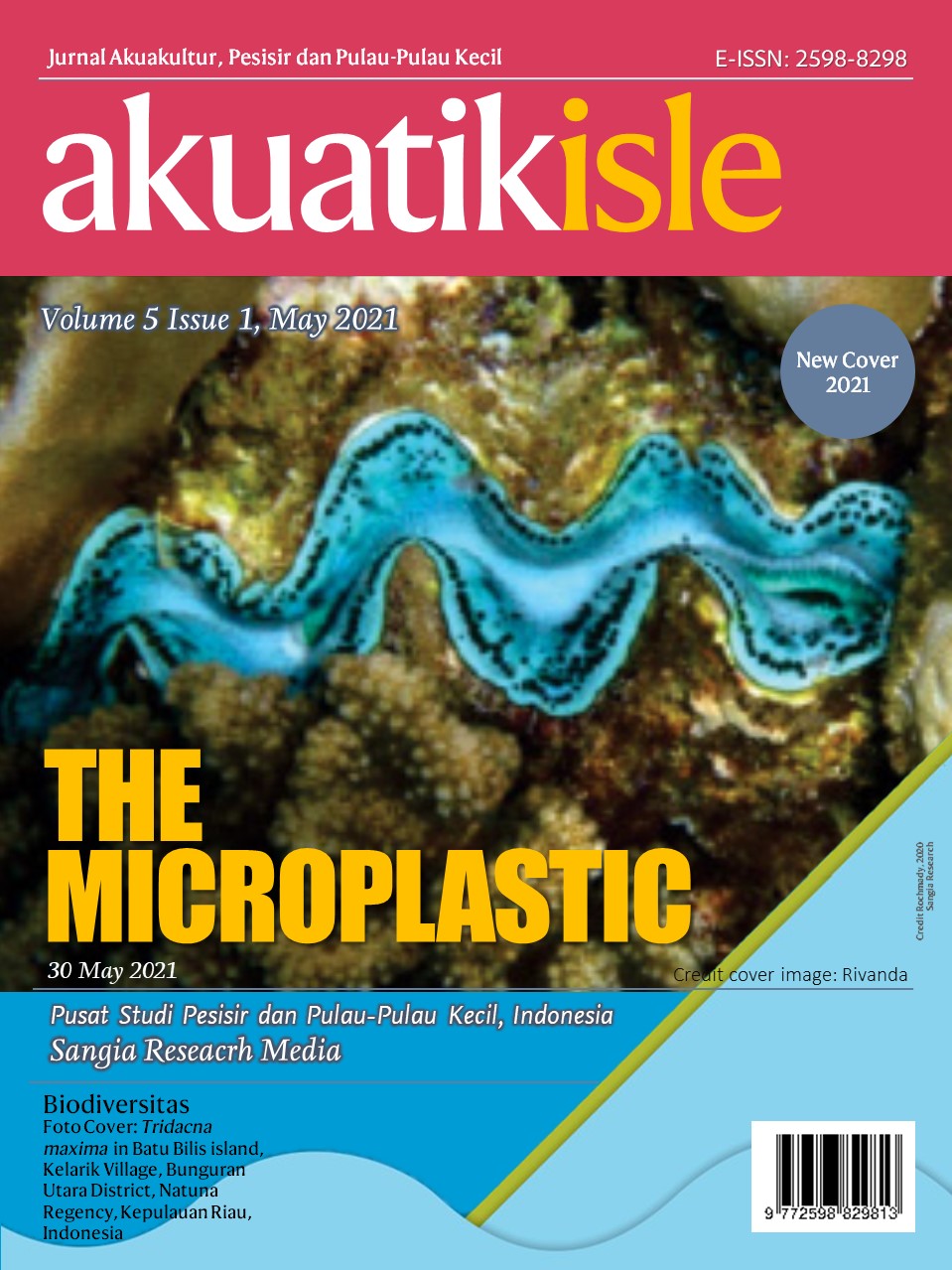Akuatikisle: Jurnal Akuakultur, Pesisir dan Pulau-Pulau Kecil
Full Length Article
Phytoplankton community as bioindicators in aquaculture media Tilapia (Oreochromis niloticus) exposed to detergent and pesticide waste
Highlights
Generate NLP AI by Wizdam ID.
Abstract
Phytoplankton is a bio-indicator of fertility in waters. This study aims to determine the impact of detergent and pesticide waste on the phytoplankton community structure in in tilapia aquaculture media. The phytoplankton identification stage was carried out at the MIPA Laboratory Almuslim University. The parameters studied were phytoplankton abundance, diversity index, uniformity index, dominance index, and water quality parameters. The results of this study showed that detergent and pesticide waste at the end of the study had caused a decrease in the abundance value of phytoplankton by 3,250 individual/L and 3,750 individual/L. In the control treatment, the highest phytoplankton composition was dominated by Chaetoceros sp., while the pesticide and detergent treatments were dominated by Golenkenia sp. and Microcystis sp. Exposure to detergent and pesticide waste reduced the diversity index value, the phytoplankton uniformity index value. At the beginning of the study, it has a moderate diversity index (H '= 2.485–3.072), while at the end of the study it shows low diversity (H' = 2.111–2.375). Furthermore, at the beginning and at the end of the study there was a decrease in the uniformity index value (E = 0.87–1.01) and (H '= 0.88–0.94).
Keywords
Introduction
Section snippets
Material and Methods
Materials and methods from the full-text PDF of this article cannot be displayed.
Results
Results from the full-text PDF of this article cannot be displayed.
Discussion
Discussion from the full-text PDF of this article cannot be displayed.
Conclusions
Conclusions from the full-text PDF of this article cannot be displayed.
Acknowledgment
Acknowledgment from the full-text PDF of this article cannot be displayed.
Funding Information
Laboratorium Matematikan dan Ilmu Pengetahuan Alam (MIPA) Universitas Almuslim
Competing interest
The authors declare that they have no known competing financial interests or personal relationships that could have appeared to influence the work reported in this paper.
Conflict of interest
The authors declare that the research was conducted in the absence of any commercial or financial relationships that could be construed as a potential conflict of interest.
Ethical approval acknowledgements
No ethical approval required for this article. All procedures followed were in accordance with the ethical standards of the responsible committee on human experimentation (institutional and national) and with the Helsinki Declaration of 1975, as revised in 2008 (5)
Supplementary files
Data sharing not applicable to this article as no datasets were generated or analysed during the current study, and/or contains supplementary material, which is available to authorized users.
References (44)
Akmal, Y.; Humairani, R. & Zulfahmi, I., 2019. Pemanfaatan Air Buangan Budidaya Ikan Lele (Clarias sp.) Sebagai Media Budidaya Daphnia sp. Jurnal Biosains dan Edukasi, 1(1): 22–27.
Amin, M. & Utojo, 2008. Komposisi dan KeragamanJenis Plankton di Perairan Teluk Kupang Provinsi Nusa Tenggara TImur. Jurnal Ilmu Kelautan dan Perikanan Universitas Hasanudin, 18(2): 129–135.
APHA, 2005. Standard methods for the examination of water and wastewater. American Public Health Association (APHA). USA. Washington, DC, 1193 p.
Basmi, J., 2000. Planktonologi: Plankton sebagai Bioindikator Kualitas Perairan. Fakultas Perikanan dan Ilmu Kelautan, Ilmu Pertanian Bogor. Bogor. 42 p.
Boyd, C. E. & Tucker, C. S., 2012. Pond aquaculture water quality management. Springer Science & Business Media, 624 p.
BPS, (Badan Pusat Statistik). 2015. Badan Pusat Statistik. Available: <https://www.bps.go.id/linkTableDinamis/view/id/895>, [Consulted: February 18, 2021].
Connel, D. W. & Miller, G. J., 1995. Kimia dan ekotoksikologi pencemaran. Penerjemah: Koestoer, Y. Judul asli: Chemistry and Ecotoxicology Of Pollution. UI-Press. Jakarta. 520 p.
Djunaidah, I. S.; Supenti, L.; Sudinno, D. & Suhrawardhan, H., 2017. Kondisi Perairan dan Struktur Komunitas Plankton di Waduk Jatigede. Jurnal Penyuluhan Perikanan dan Kelautan, 11(2): 79–93, https://doi.org/10.33378/jppik.v11i2.87.
Halang, B., 2018. Toksisitas Air Limbah Deterjen Terhadap Ikan Mas (Cyprinus carprio). Bioscientiae, 1(1): 39–49.
Haumahu, S., 2005. Distribusi Spasial Fitoplankton di Perairan Teluk Haria Saparua, Maluku Tengah. Ilmu Kelautan: Indonesian Journal of Marine Sciences, 10(3): 126–134, https://doi.org/10.14710/ik.ijms.10.3.126-134.
Indrayani, N.; Anggoro, S. & Suryanto, A., 2014. Indeks Trofik-Saprobik Sebagai Indikator Kualitas Air di Bendung Kembang Kempis Wedung, Kabupaten Demak. Management of Aquatic Resources Journal (MAQUARES), 3(4): 161–168, https://doi.org/10.14710/marj.v3i4.7051.
Kamiswari, R., 2013. Pengaruh Pemberian Deterjen terhadap Mortalitas Ikan Platy sp. LenteraBio: Berkala Ilmiah Biologi, 2(1): 139–142.
Khairuman, S. P.; Amri, K. & Pi, S., 2008. Buku Pintar Budi Daya 15 Ikan Konsumsi. AgroMedia. Jakarta, 268 p.
Koesoemadinata, S., 2017. Toksisitas Akut Formuilasi Insektisida Endosulfan, Klorpirifos, Dan Klorfluazuron Pada Tiga Jenis Ikan Air Tawar Dan Udang Galah. Jurnal Penelitian Perikanan Indonesia, 6(3–4): 36–43, https://doi.org/10.15578/jppi.6.3-4.2000.36-43.
Kusriani, K.; Widjanarko, P. & Rohmawati, N., 2012. Uji pengaruh sublethal pestisida diazinon 60 EC terhadap rasio konversi pakan (FCR) dan pertumbuhan ikan Mas (Cyprinus carpio L.). Jurnal Penelitian Perikanan, 1(1): 36–42.
Ludwig, J. A.; QUARTET, L.; Reynolds, J. F. & Reynolds, J. F., 1998. Statistical ecology: a primer in methods and computing. John Wiley & Sons. Singapore. 337 p.
Magfirah, M.; Adhar, S. & Ezraneti, R., 2015. Efek surfaktan terhadap pertumbuhan, kelangsungan hidup dan struktur jaringan insang benih Ikan Nila (Oreochromis niloticus). Acta Aquatica: Aquatic Sciences Journal, 2(2): 90–96. https://doi.org/10.29103/aa.v2i2.340
Makmur, M.; Kusnoputranto, H.; Moersidik, S. S. & Wisnubroto, D. S., 2013. Pengaruh limbah organik dan rasio n/p terhadap kelimpahan fitoplankton di kawasan budidaya kerang hijau Cilincing. Jurnal Teknologi Pengelolaan Limbah, 15(2): 51–64.
Makmur, R. & Fahrur, M., 2011. Hubungan antara kualitas air dan plankton di tambak Kabupaten Tanjung Jabung Barat Provinsi Jambi. In: Prosiding Forum Inovasi Teknologi Akuakultur, Vol. 2, pp. 961–968.
Maresi, S. R. P.; Priyanti, P. & Yunita, E., 2015. Fitoplankton sebagai bioindikator saprobitas perairan di Situ Bulakan Kota Tangerang. Al-Kauniyah: Jurnal Biologi, 8(2): 113–122, https://doi.org/10.15408/kauniyah.v8i2.2697.
Muliari, M. & Zulfahmi, I., 2016. Impact of palm oil mill effluent towards phytoplankton community in Krueng Mane River, North Aceh. Jurnal Perikanan dan Kelautan, 6(2): 137–146, https://doi.org/10.33512/jpk.v6i2.1107.
Nopiantari, N. P. V.; Arthana, I. W. & Astarini, I. A., 2017. Dampak kegiatan pertanian terhadap tingkat eutrofikasi dan jenis–jenis fitoplankton di Danau Buyan Kabupaten Buleleng Provinsi Bali. ECOTROPHIC: Jurnal Ilmu Lingkungan (Journal of Environmental Science), 11(1): 47–54. https://doi.org/10.24843/EJES.2017.v11.i01.p08
Nugroho, A., 2006. Bioindikator kualitas air. Universitas Trisakti. Jakarta. 145 p.
Odum, E. P., 1996. Dasar-dasar Ekologi. Edisi Ketiga. Penerjemah Samingan, Tjahjono. Gadjah Mada University Press. Yogyakarta. 697 p.
Prihantini, N. B.; Wardhana, W.; Hendrayanti, D.; Widyawan, A.; Ariyani, Y. & Rianto, R., 2010. Biodiversitas Cyanobacteria dari beberapa situ/danau di kawasan Jakarta-Depok-Bogor, Indonesia. Makara Journal of Science, 12(1): 44-54. https://doi.org/10.7454/mss.v12i1.309.
Rudiyanti, S., 2009. Kualitas perairan sungai Banger Pekalongan berdasarkan indikator biologis. Saintek Perikanan: Indonesian Journal of Fisheries Science and Technology, 4(2): 46–52, https://doi.org/10.14710/ijfst.4.2.46-52.
Rudiyanti, S. & Dana, A., 2009. Pertumbuhan dan survival rate ikan mas (Cyprinus carpio Linn) pada berbagai konsentrasi pestisida regent 0, 3 g. Saintek Perikanan, 5(1): 49–54.
Sagala, E. P., 2010. Indeks Saprobik Komunitas dalam Menentukan Tingkat Pencemaran di Perairan Laut antara Muara Sungai Benu dan Pulan Betet, Kabupaten Banyuasin, Provinsi Sumatera Selatan. Maspari Journal, 2: 11–18.
Sahabuddin, E. S., 2012. Cemaran air dan tercapainya lingkungan sumber daya alam yang berkelanjutan. Publikasi Pendidikan, 2(2): 102–111, https://doi.org/10.26858/publikan.v2i2.1411.
Saputra, E.; Taqwa, F. H. & Fitrani, M., 2013. Kelangsungan hidup dan pertumbuhan benih nila (Oreochromis niloticus) selama pemeliharaan dengan padat tebar berbeda di lahan pasang surut Telang 2 Banyuasin. Jurnal Lahan Suboptimal: Journal of Suboptimal Lands, 2(2): 197–205, https://doi.org/10.33230/JLSO.2.2.2013.70.
Sastrawijaya, A. T., 2000. Pencemaran Lingkungan, Vol. 2, PT Rineka Cipta. Jakarta. 274 p.
Singh, R. N., 2013. Acute toxicity of an organophosphate, dimethoate to an air breathing fish, Colisa fasciatus (Bl. & Schn.). Indian Journal of Scientific Research, 4(1): 97–100.
Soetrisno, Y., 2008. Kualitas air dan dinamika fitoplankton di perairan Pulau Harapan. Jurnal Hidrosfir Indonesia, 3(2): 87–94.
Suprobo, H. D.; Anggoro, S. & Soedarsono, P., 2013. Penilaian pencemaran perairan di Polder Tawang Semarang ditinjau dari aspek saprobitas. Management of Aquatic Resources Journal (MAQUARES), 2(3): 109–118, https://doi.org/10.14710/marj.v2i3.4192.
Swary, A. & Hutabarat, S., 2014. Studi Pengaruhnya Deterjen terhadap Komposisi dan Kelimpahan Fitoplankton di Sungai Banjir Kanal Timur Semarang. Journal of Management of Aquatic Resources, 3(2): 157–165, https://doi.org/10.14710/marj.v3i2.5022.
Tarwotjo, U.; Situmorang, J.; Soesilohadi, H. R. & Martono, E., 2014. Monitoring Resistensi Populasi Plutella xylostella, L Terhadap Residu Emamektin Benzoat Di Sentra Produksi Tanaman Kubis Propinsi Jawa Tengah (Monitoring the Resistance of Plutella xylostella, L Population Against Emamektin Benzoate Residues). Jurnal Manusia dan Lingkungan, 21(2): 202–212, https://doi.org/10.22146/jml.18545.
Wahyudiati, N. W. D.; Arthana, I. W. & Kartika, G. R. A., 2017. Struktur Komunitas Zooplankton di Bendungan Telaga Tunjung, Kabupaten Tabanan-Bali. Journal of Marine and Aquatic Sciences, 3(1): 115–122. https://doi.org/10.24843/jmas.2017.v3.i01.115-122
Wibowo, A., 2004. Kinetika Bioakumulasi Logam Berat Kadmium Oleh Fitoplankton Chlorella sp. Lingkungan Perairan Laut. Jurnal Penelitian Sains & Teknologi, 5(2): 89–103.
Wibowo, P. & Kalatham, T. P., 2017. Panduan Praktis Penggunaan Pupuk dan Pestisida. Penebar Swadaya Group. Jakarta. 98 p.
Wijaya, T. S. & Hariyati, R., 2011. Struktur komunitas fitoplankton sebagai bio indikator kualitas perairan Danau Rawapening Kabupaten Semarang Jawa Tengah. Anatomi Fisiologi, 19(1): 55–61.
Wijayanti, 2011. Keragaman Jenis Plankton Pada Tempat Yang Berbeda Kondisi Lingkungannya Di Rawa Pening Kabupaten Semarang. [Skripsi]. IKIP PGRI Semarang. Semarang.
Wilhm, J. L. & Dorris, T. C., 1968. Biological parameters for water quality criteria. Bioscience, 18(6): 477–481. https://doi.org/10.2307/1294272
Wisha, U. J.; Yusuf, M. & Maslukah, L., 2016. Kelimpahan fitoplankton dan konsentrasi tss sebagai indikator penentu kondisi perairan Muara Sungai Porong. Jurnal Kelautan: Indonesian Journal of Marine Science and Technology, 9(2): 122–129, https://doi.org/10.21107/jk.v9i2.1298.
Zulfahmi, I. & Akmal, Y., 2020. Ekotoksikologi Akuatik. PT Penerbit IPB Press. Bogor. 138 p.
Bibliographic Information
Cite this article as:
-
Submitted
18 January 2021 -
Revised
1 February 2021 -
Accepted
4 March 2021 -
Published
6 March 2021 -
Version of record
9 April 2021 -
Issue date
30 May 2021
-
Academic subject
Environmental Science
Keywords
Copyright
Sangia Advertisement
At the first time, plastic materials were produced to facilitate various activities of human life. Plastic materials that are flexible and durable pollution both on land and the sea. Plastic materials that are not managed properly can contaminate human and life, either directly or indirectly to food sources, especially food from the sea.
Copyright © 2021 Yusrizal Akmal, Rindhira Humairani, Muliari, Hanum, Ilham Zulfahmi. Sangia Research Media and Publishing. Production and hosting by Sangia (SRM™).  This work is licensed under a Creative Commons Attribution-ShareAlike 4.0 International License.
This work is licensed under a Creative Commons Attribution-ShareAlike 4.0 International License.
Disclaimer: All claims expressed in this article are solely those of the authors and do not necessarily represent those of their affiliated organizations, or those of the publisher, the editors and the reviewers. Any product that may be evaluated in this article or claim that may be made by its manufacturer is not guaranteed or endorsed by the publisher.
Comments on this article
By submitting a comment you agree to abide by our Terms and Community Guidelines. If you find something abusive or that does not comply with our terms or guidelines please flag it as inappropriate.










